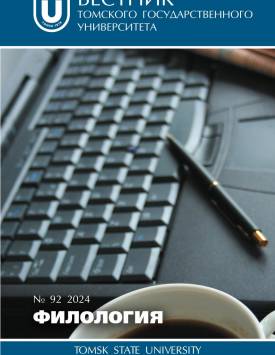The person's postmortem transformation through interpretation of masters of fantasy
The article highlights the results of the investigation of the Universe of Afterlife as a special locus of the postmortem existence of a human being (soul) from the viewpoint of fantasy worlds' writers. The analysis involves fantasy works by Russian, European and US writers, created in the 20th and 21st centuries, and corresponding to three criteria: the Universe of Afterlife is depicted in them as a locus, marked by geographical, landscape, ethnic, social, moral and other characteristics; the given locus is identified as the postmortem world both by a writer and a reader; the postmortem world description plays the principal (or significant) role in the plotline development and serves as a means of the author's intention and idea interpretation. The given work aims at defining the functions of the artistic image of the Universe of Afterlife, related to the authors' conceptions of the purport of postmortem existence. The article introduces a wide range of such conceptions, structured according to: (1) the postmortem existence duration ("finite" and "infinite" afterlife; (2) the presence or absence of personages' inner evolution and the mainstream trend of this evolution. "Finiteness" of afterlife implies both the completion of a person's existence in it and the time interval of the Universe of Afterlife existence. The former comprises the cases of getting to the postmortem world of not yet dead personages as a result of some error or mishap, after a suicide attempt, or in the state of sleep, coma, etc.; literary personages' travelling to the Universe of Afterlife of with a view of getting back the souls of dear people; as well as the hypotheses of reincarnation (or multiple reincarnations) of human souls, when the afterlife becomes a short timespan among earthly lives (Jarosław Grzędowicz's Wilcza zamieć, 2005; Robert Young's On the River, 1965; Anna Starobinets' Asylum 3/9, 2006; Stephen King's Afterlife, 2013). The personages' postmortem existence in them, as a rule, is predetermined by the need of getting a proper moral lesson, resulting in the personages' partial or full changes in their successive earthly lives. The "finiteness" of the Universe of Afterlife, in its turn, may be caused by its peculiar "intermediate" nature as the Zone of Transition, from which a personage can choose his way out either "back" - to the earthly life, or "forward" - into "the terminal death" (Graham Joyce's The Silent Land, 2010); or it may be influenced by the consequences of some mishap, which led to the "optional" afterlife emergence (Ursula Le Guin's Earthsea, 1964-2001). In postmortem eternity, the inner evolutionary trend of personages may be characterized as negative - anomie, moral degeneration (Hermann Kasack's Die Stadt hinter dem Strom, 1947), or as positive. The latter (Clive Lewis' The Great Divorce, 1945; Richard Matheson's What Dreams May Come, 1978) presupposes that the afterlife alongside the earthly life becomes an essential stage of the common path of spiritual growth leading to the reunion with God. The author declares no conflicts of interests.
Keywords
20th/21st century fantasy, person's postmortem transformation, Universe of Afterlife, postmortem existenceAuthors
| Name | Organization | |
| Kovtun Elena N. | Institute of Slavic Studies of the Russian Academy of Sciences | kovelen@mail.ru |
References

The person's postmortem transformation through interpretation of masters of fantasy | Vestnik Tomskogo gosudarstvennogo universiteta. Filologiya – Tomsk State University Journal of Philology. 2024. № 92. DOI: 10.17223/19986645/92/9
